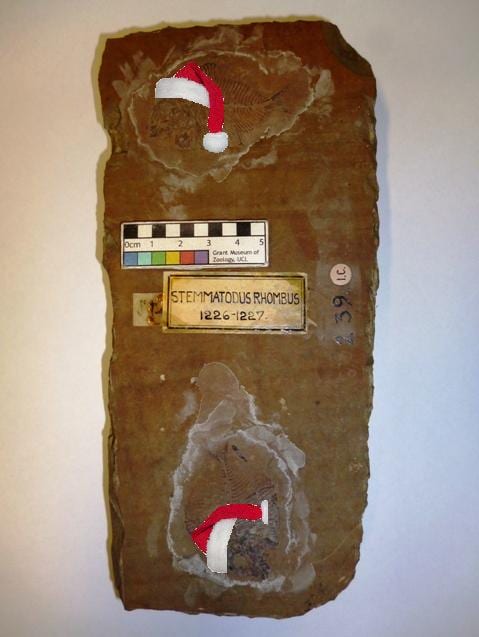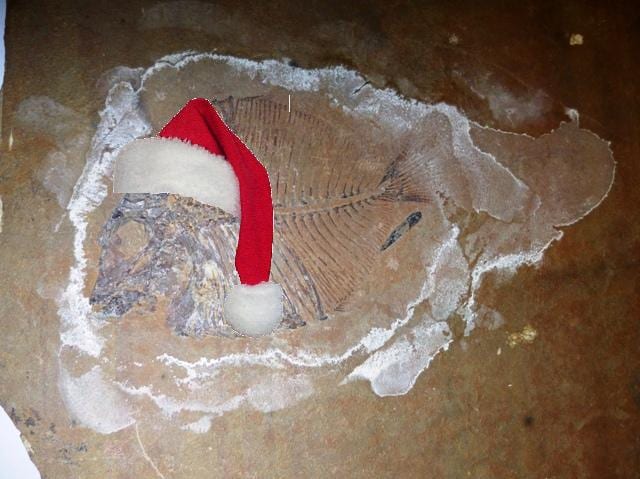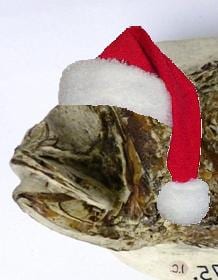Underwhelming Fossil Fish of the Month: December 2013
By Mark Carnall, on 19 December 2013
Twas the night before Christmas
When all through the Grant Museum
Not a creature was stirring
Because it was a zoology museum and all the animals had stirred their last a long time ago
Doubly so for fossil fish.
It has long been assumed that Christmas is a very mammalian celebration. 2013 years ago Santa invented Coca-Cola and ever since humans have been celebrating by writing each other cards, giving each other presents and eating too many Twiglets. However, there’s compelling evidence that Christmas has its origins deep in the geological past. (Christmas) puddingstones date back to the Pleistocene. Christmas Island is over 100 million years old. Christmas trees evolved back in the Carboniferous. Christmas songs celebrate Rocking around the Christmas Tree. Surely it’s no coincidence that many fossil fish are composed of rock today. It’s entirely possible (plausible is a stretch) that the-yet-unfossilised fossil fish celebrated Christmas in Devonian seas and possibly even further back.
However, the origins of Christmas in the fossil record have been poorly studied. More research is needed to confirm a non-mammalian origin of Christmas hypothesis. Until then, let’s take a cold hard festive stare at yet another Underwhelming Fossil Fish from the Grant Museum’s collections. This month I’ve got nothing particularly special lined up for you.
Here’s this month’s fossil fish. Earlier I said that I didn’t have anything particularly special lined up but I hope you’ll forgive my little white lie because we’ve got a DOUBLE FOSSIL FISH SPECIAL.

LDUCZ-V1502 DOUBLE FOSSIL FISH SPECIAL! Two fossil fish for the price of one: Dancer (top) and Prancer (below). It’s the thought that counts.
To the untrained eye it may appear that these fish have been preserved perhaps mid-Christmas party. Perhaps the white shrouds that surround them are snow angels? Don’t be misled fair reader that’s your eyes and your mind trying to make this specimen more interesting than it actually is. The ‘shrouds’ are a preservation artefact. The reality is that these fish were probably horribly suffocated and buried alive. Prancer appears to have defecated during death which has also been preserved here. Ho ho ho Merry Christmas.
According to the always reliable label for this specimen, we have two Stemmatodus rhombus individuals here. If the identification can be trusted then I can fairly confidently suggest that this specimen was collected in Castellammarre di Stabia near Naples in Italy, the only location that fish of this species have ever been found (of course, they could be from an hitherto undiscovered locality however, they don’t have any collection data with them). Stemmatodus rhombus is a species of Pycnodontid fish, a group of bony fish with flattened teeth for crushing molluscs and other shelled creatures. Stemmatodus rhombus lived approximately 130 million years ago but the entire Pycnodontiformes order ranged from the Late Triassic and went extinct in the Eocene a mere 33 million years ago.
Preservation These fossil fish are excellently preserved, well enough to discern the skeletal anatomy, stomach contents and detail of the teeth. The depositional environment from the locality these were most likely collected from is thought to have been a lagoonal environment, individuals like these buried by sand and muds accounting for the excellent preservation.

Close up of Prancer showing the fine detailed preservation of the skeleton and possibly a coprolite too on the lower right underneath the tail
Research For fish so well preserved and, from searching museum databases online, fairly common in museum collections there has been surprisingly little research on this species since their original discovery and description by legendary palaeontologist Louis Agassiz in 1844. The species is mentioned here and there throughout the literature mostly in the context of describing the pycnodontiform tooth arrangements which fossils like these can lend themselves to.
In Society Normally, when I’m trying to research this section for these posts there are at least a couple of people who have obscure fossil fish taxa as usernames but not this time. So if you’re looking for a unique Internet handle or child’s name could I suggest Stemmatodus to help you stand out from the crowd? Yes it may sound like some sort of toxin designed to keep frogs out of your garden but at least the personalised license plate is probably cheaper than J0hn 5m1th. Entrepreneurs and inventors Stemmatodus sounds like an excellent product or business name and you’d quickly rise to the top of Internet search engines.
Stemmatodus rhombus
Preservation 8
Research 2.3333
In Society 0
Underwhelmingness 5
Mark Carnall is the Curator of the Grant Museum of Zoology and wishes you a very Underwhelming festive break. Remember a fossil fish is for life not just for Christmas.
4 Responses to “Underwhelming Fossil Fish of the Month: December 2013”
- 1
-
2
Isabelle Lundqvist wrote on 22 December 2013:
Very happy to see this months Underwhelming Fossil Fish roll out before Christmas. Perfect way to end the workyear and begin the holidays!
Merry Fishmas! (Oh, see what I did there?!?)
-
3
Steve wrote on 5 January 2014:
You are a true poet Mark. In particular, the revelation that your specimens don’t move much struck a cord.
Considering how long they have been lying still, one might expect the urge to flick a fin or to shimmy in their alluvial silt to alleviate cramp would be simply overwhelming. However, after many hours spent staring, unblinking, at fossil fish I have never once seen them move.
It’s as though they had been cast in stone. Remarkable!
I would also like to know if the Christmas copralites are available at retailers. There’s somebody I’d like to send one to.
-
4
Underwhelming Fossil Fish of the Month: August 2014 | UCL UCL Museums & Collections Blog wrote on 29 August 2014:

[…] an extinct genus of pycnodontid fish, underwhelming fossil fish fans will remember this festive edition featuring related genus Stemmatodus back in December. What we have here appears to be the opposite of the business end of the creature […]
 Close
Close



I’ve worked it out – you’re manufacturing these “specimens” each month. That’s why they’re so underwhelming in research and society. They never existed before you made them. There’s no such thing as fossil fish.